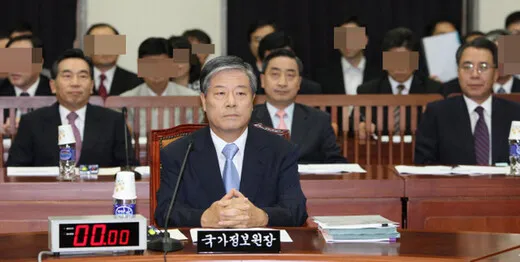hankyoreh
Links to other country sites 다른 나라 사이트 링크
The low down on S. Korea’s intelligence gathering techniques

National Intelligence Service Director Kim Sung-ho told the National Assembly’s Intelligence Committee on September 10 that North Korean leader Kim Jong-il had problems with his circulation, but was getting better, and could walk around with assistance.
Director Kim’s report was vivid, as if he had seen with his own eyes the North Korean leader’s condition. How was the NIS director able to learn so minutely -- as if looking at the back of his own hand -- Kim Jong-il’s condition, which the North Korean authorities keep as a closely-guarded secret? Moreover, how reliable is this intelligence?
One of the important duties of the NIS and other intelligence organs is to learn the movements and whereabouts of Kim Jong-il. In particular, they put out feelers even for small signs and unconfirmed information about Kim’s health.
Intelligence organs usually analyze photos and videos of Kim’s public activities along with medical experts. The sudden appearance of European and Chinese medical teams in Pyongyang, too, says something about Kim’s health.
For security reasons, it is impossible to know how these details about Kim’s condition become known, but it is reportedly confirmed in the end through human intelligence.
The intelligence on North Korea gathered by South Korea, the United States and Japan can be broadly divided into human intelligence gathered by people, signal intelligence gathered using scientific equipment such as spy satellites, and electronic intelligence from devices such as communication bugs and surveillance.
The United States is strong in signal and electronic intelligence. U.S. spy satellites film the ground with super-precision cameras and pick up communications from ground lines and cell phones, faxes and wireless radios.
South Korea is weaker in signal and electronic intelligence than the United States, but it is reportedly stronger in human intelligence and analysis. When they get a piece of intelligence related to Kim’s condition, South Korean intelligence bodies first look at the rank, degree of access available and reliability of the source. They analyze the reliability of information previously provided by the source, and, by reconstructing the intelligence, they accept what they conclude should be accepted and ignore what should be ignored. The intelligence bodies first judge whether to accept the intelligence by reconstructing the entire process through which the tip was obtained, including the birth of the intelligence or rumor and the process by which it spread. Once a piece of intelligence is adopted, all sorts of signs are confirmed using a check list to reconfirm it. After this is done, it becomes a real piece of intelligence.
One government official said rumors of Kim’s illness are still in the unconfirmed intelligence stage. This means it still needs to go through a rigorous process of confirmation.
Please direct questions or comments to [englishhani@hani.co.kr]
Editorial・opinion
![[Column] The end of the road for NewJeans, or a new beginning? [Column] The end of the road for NewJeans, or a new beginning?](https://flexible.img.hani.co.kr/flexible/normal/500/300/imgdb/original/2025/1022/3617611258545507.jpg) [Column] The end of the road for NewJeans, or a new beginning?
[Column] The end of the road for NewJeans, or a new beginning?![[Editorial] Korea must prepare for rough road ahead with Japan [Editorial] Korea must prepare for rough road ahead with Japan](https://flexible.img.hani.co.kr/flexible/normal/500/300/imgdb/original/2025/1022/5517611229374291.jpg) [Editorial] Korea must prepare for rough road ahead with Japan
[Editorial] Korea must prepare for rough road ahead with Japan- [Editorial] Korea cannot afford to rush to a deal with the US
- [Column] Shared dilemmas at a historic turning point for Korea, Europe
- [Column] Halfway across the world, I’m cheering on Americans fighting for democracy
- [Column] How meritocracy turns into tyranny
- [Column] The real scandal of Korea’s ‘divorce of the century’
- [Column] The meritocracy to fascism pipeline
- [Column] Korea is not an enemy to be plundered
- [Column] Chaebol can’t take credit for KOSPI’s record rally
Most viewed articles
- 1Behind far right’s success is the failure of establishment parties, says expert
- 2North Korea fires ballistic missile toward East Sea
- 3Trump’s interest in Kim Jong-un stems from real estate development hopes, says ex-US official
- 4[Editorial] Korea must prepare for rough road ahead with Japan
- 5[Column] The end of the road for NewJeans, or a new beginning?
- 6[Interview] Politics of care as an antidote to divisions caused by meritocracy
- 7New hard-right Japanese PM poses test for Lee’s vision of Seoul-Tokyo cooperation
- 8World's top tennis player faces No. 2 in exhibition event in Seoul
- 9Senior Korean officials head back to US for final coordination before summit next week
- 10Korea’s Democrats unveil plan to expand Supreme Court from 14 to 26 justices